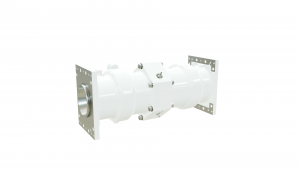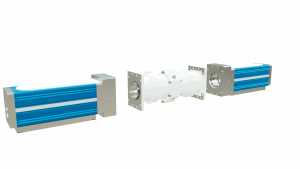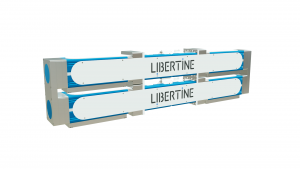Libertine: realising the potential of linear generators
Libertine FPE’s integrated linear elegant electric machines
This successful alumni of the Advanced Propulsion Centre’s accelerator programme has risen from SME to IPO in just a few short years, by finding a compelling business case for their motor technology.
For all the advances in battery technology in recent years, there are still numerous applications where liquid or gas fuels simply make more sense. Far higher energy densities, rapid refuelling and the ability to operate for prolonged periods away from the grid mean that combustion engines are likely to remain in a lot of these applications.
As the application of new technologies evolves, the combustion engine is increasingly being used as a generator rather than a direct power source. For instance, it’s envisaged that heavy trucks might use an electric drivetrain to move the wheels using a sustainable fuel to power a series hybrid system (i.e. wheels driven by the electric motor) or a range extender.
With no requirement to provide a direct mechanical drive to the wheels, harnessing the benefits of a combustible fuel no longer has to mean using a traditional reciprocating engine. One alternative that has been put forward is the linear generator, also known as a free piston engine. This uses an unconstrained piston that moves back and forth in the cylinder, under the action of combustion pressure at one end and a pneumatic spring at the other.
Linear generators offer numerous theoretical benefits, ranging from dramatically increased thermal efficiency to multi-fuel operation. Traditionally, however, they have been held back by the challenges of controlling piston motion and efficiently extracting power from the working chamber.
Libertine FPE believes it has developed a solution to both these problems. It has discovered that by integrating a linear electric machine (LEM), with its proprietary control architecture, into a linear generator, it can control this motion and directly convert it into electrical energy.
Business planning
It’s an incredibly elegant solution, and one that the company was seeking help to commercialise when it joined the APC’s Technology Developer Accelerator Programme (TDAP) in 2017.
“Our technology is linear electrical machines and control systems. We help our customers build that into their linear generator product developments,” explains Sam Cockerill, Founder of Libertine. “When we joined TDAP, we were wondering where to focus our business case. The programme helped us to identify heavy-duty powertrains and distributed power as two key applications.”
With the expert insight from the APC’s partner organisations, this business planning activity helped the company to assess the market size, the risks and the potential value of its technology in a range of different segments. It helped to steer the focus away from light duty passenger car applications – where ‘pure’ battery electric powertrains are likely to dominate – into other areas.
“The legacy of that work is still here in the business plans we work with today and how we’ve looked at the addressable market opportunity for our technology platform,” notes Cockerill.
Public listing
TDAP provided financial assistance, with over £100,000 of grant funding and support. Part of this was put towards demonstration units and mock ups that helped to illustrate the scalability of the technology.
“The beauty of this technology is that it can be scaled from large format systems in truck and bus powertrains right down to portable power applications or, in the future, maybe micro CHP systems in the home,” comments Cockerill.
The APC also provided Libertine with an introduction to investment banking firm Panmure Gordon, which subsequently assisted the company with its £9 million AIM listing on the London Stock Exchange in 2021.
“That happened as a direct result of the APC making the introduction, based on their knowledge of Libertine and their knowledge of Panmure Gordon,” comments Cockerill. “That was a real door opener for us, and it has worked successfully because the APC genuinely understood the two organisations and how we could work together.”
Between the beginning of the TDAP project in 2017 and the end of 2021, Libertine’s annual revenue rose from around £100,000 to approximately £3 million. Cockerill believes this growth trajectory was one of the main factors that enabled the company to carry out its AIM listing. Since then, Libertine has continued to grow and establish relationships with new partners, such as MAHLE Powertrain, with which it has instigated a £2.6 million project to develop low carbon powertrains for heavy duty vehicles.


